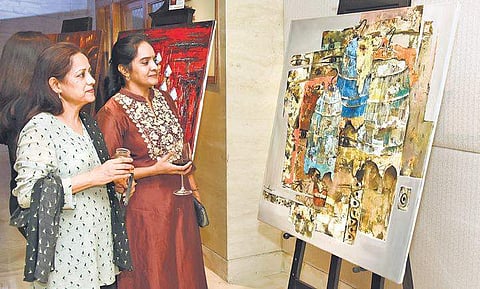

Historically, women have faced barriers in all forms of existence, be it education or exposure. Despite the challenges, both personal and societal, they have emerged victorious. Their roles in society have been shaped by a multitude of factors spanning cultural and political dimensions, each leaving an imprint on the broader canvas. The traditional gender norms cornered women into the household acknowledging only the domestic space as a feminine stronghold. But today, women have risen as pioneers, assuming leadership positions across realms, from science, academia and the social sector.
Art functions as a mirror, reflecting the impact of cultural shifts within society. Women artists have played a pivotal role in shaping and reshaping the landscape of contemporary Indian art. Following the fearless footsteps of artists like Amrita Sher-Gil and Nasreen Mohamedi, the new generation brings its unique perspectives to address issues of gender and tradition prevalent in Indian society.
Defying social norms, artists such as Mrinalini Mukherjee, Neelima Sheikh, Madhvi Parekh, Arpita Singh and many others have attempted to illustrate and reveal the multifaceted layers of Indian culture. Sher-Gil’s emotionally charged work often challenged the status quo with her narrative depth and cultural sensitivity, while others—for instance, Zarina Hashmi,Anupam Sud, Anjolie Ela Menon, Arpana Caur, Nalini Malani, Bharti Kher and Jayasri Burman—have addressed issues surrounding gender, identity and ecology.
Through sheer determination, immense talent and unrelenting fortitude, women artists from India have carved out a powerful space for themselves. Their stories and bodies of work transcend borders and endure as a testament to their resilience and artistry.
Upon my recent attendance at the G20 conference on women empowerment, I was deeply inspired by women coming from all walks of life—agriculture, research, education, art, technology and media. Among the many I was fortunate to meet, scientist Tessy Thomas and forester Rasilaben Vadher left a deep impact. The humble nature of both echoed a message of strength, recognising the power of women-led development. Thomas, the first Indian woman scientist to head a missile project, and Vadher, first woman forest guard in Gujarat’s Gir National Park, narrated anecdotes about their experiences in largely male-dominated fields and their journey in breaking barriers.
Their indomitable spirit defines the power of womanhood today. As we progress as a civilisation, we also recognise the enduring power of art in shaping societies, challenging perceptions and acting as a catalyst of change towards a more inclusive and egalitarian society.
Sunaina Anand
Founder and Director, Art Alive Gallery, New Delhi
sunaina@artalivegallery.com